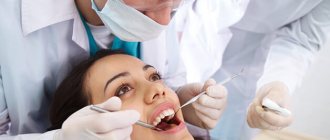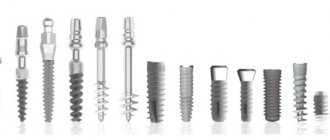The science of dentistry, fortunately for many, many of us, is developing by leaps and bounds. In the 21st century, if a person is missing 1-2 teeth, he does not have to get a bridge and spoil the adjacent rows; he can simply have an implant installed. We all know about the benefits of this type of prosthetics, but we rarely pay attention to the dangers of such work. Let's discuss possible gum inflammation after implant placement and ways to avoid it.
Before deciding to undergo dental implantation, you should understand that this is a rather complex and traumatic procedure. You should be prepared for the natural consequences of such an intervention - pain, swelling, bleeding.
When a foreign body is implanted, unpleasant sensations in the gums and jawbone are inevitable. However, if the operation was successful and the body accepts the new “roots” well, all unpleasant symptoms disappear after a few days. But if the days go by and the condition does not improve, it is worth considering additional gum support.
When is bleeding after implantation normal?
After implantation of the artificial root, minor bleeding may occur for 3-4 hours. This is a normal reaction of the body, because cutting the gum tissue involves damage to the blood vessels.
Along with the ichor, pathogenic microorganisms are washed out of the operated area, and the release of blood minimizes the risk of developing an inflammatory process.
Sometimes moderate hemorrhage lasts from a day to 2-4 days. It all depends on the blood clotting index of a particular person. If blood is being released for a week or longer, you should urgently see a doctor .
Along with bleeding, the following symptoms often occur:
- pain;
- swelling;
- increased body temperature;
- total inflammation of the suture area.
The listed symptoms usually disappear on the fourth day after surgery, the general condition returns to normal, and the feeling of discomfort gradually goes away.
Implantologist's opinion : “Bleeding can occur not only after implantation, but also after prosthetics. The reason for this may be poor-quality fixation of crowns and dentures. Food particles remain in the gaps, which leads to inflammation and bleeding of the gums. If this happens, a complete replacement of the orthopedic structure will be required.”
Treatment of peri-implantitis –
Treatment of peri-implantitis is carried out only if the implant is immobile. If the mobility of the implant is determined, only its removal is indicated. Also, before starting treatment, it is important to assess the presence of increased chewing load on the implant, and if it exists, first of all it is necessary to neutralize it.
In addition, if a purulent abscess has formed in the implant area, then emergency opening of the abscess + systemic antibacterial therapy is necessary. To treat mucositis, only conservative methods are generally used (such as mechanical and antiseptic treatment of implants, antibacterial therapy), and surgical intervention may only be required to increase the thickness of the gums or the width of the attached gum.
But for the treatment of peri-implantitis, the main method will be only surgical treatment aimed at removing granulations from under the gums, replanting a bone graft with the parallel use of a barrier membrane.
1) Implant surface treatment –
With peri-implantitis, bone tissue is destroyed, which leads to partial exposure of the root surface of the implant. Because Since the latter has high porosity, it is subject to rapid contamination by pathogenic microflora. At the first stage of treatment, it is very important to disinfect the surface of the implant, removing all microbial plaques from the surface, plus carry out an antiseptic treatment.
For mechanical treatment of the implant surface, the following can be used:
- mechanical curettage,
- erbium laser (video 1),
- ultrasonic tip (video 2),
- sandblasting (Air-Flow).
The disadvantage of cleaning the implant surface using curettage or ultrasonic tips with metal tips is the high risk of injury to the titanium oxide layer on the implant surface, which can cause corrosion of the implant and lead to a new development of peri-implantitis. Therefore, it is best to use an erbium laser if available.
Next, an antiseptic surface treatment is carried out with either 3% hydrogen peroxide or a 0.1% chlorhexidine solution. Immediately after treatment with these antiseptics, it is necessary to treat the surface of the implant with a gauze swab with saline solution.
2) Systemic antibacterial therapy –
In other articles, we have already said that the ideal option for preventing peri-implantitis is a microbiological analysis of the microflora of the oral cavity, as well as its sensitivity to various antibiotics - performed even before the surgical stage of implantation. If extremely pathogenic microflora is inoculated, systemic antibiotic therapy is carried out even before surgery, which sharply reduces the risk of developing inflammation around the implant.
However, if there is no need to take antibiotics before surgery, this analysis will allow you, in the event of peri-implantitis, to immediately prescribe the best antibiotic option that will specifically target specific pathogenic microorganisms in a given patient. Believe me, this is important, because... Cases of resistance to broad-spectrum antibiotics are common.
There are clinical cases when the microflora in peri-implantitis does not respond not just to Amoxicillin, but also to Rovamycin or Vilprofen (a group of macrolides), and even sometimes to Ceftriaxone (a group of cephalosporins). In this case, a preliminary study of the microflora will allow you to save patients from removal of implants or large-scale reconstructive surgeries.
Read more about the use of antibiotics in the article: → “Antibiotic therapy strategy for implantation”
3) Surgical treatment (NTR technique) –
If peri-implantitis occurs, the treatment is predominantly surgical, and all of the above preliminary points are only secondary and necessary (as preparation for surgery). Surgical treatment is aimed at removing inflammatory granulations that form at the site of resorbed bone, as well as increasing the level of bone tissue using guided tissue regeneration (GTR).
Only surgical access allows you to remove all inflammatory granulations from under the gums, as well as mechanically and antiseptically treat the surface of the implants in the bone pockets. Absolutely all clinical studies have shown that conservative therapy for peri-implantitis (without surgical intervention, aimed at removing granulations and allowing for total disinfection of the root surface of the implant) is absolutely ineffective.
Surgical strategy : During surgery, the mucoperiosteal flap (gum) is removed to expose the surface of the implant and visualize the bone defect around the implant. Next, using curettage, scaling, and an erbium laser, all inflammatory granulations are removed, and antimicrobial treatment of the surface of the implant and bone defect is carried out. Subsequent actions will depend on the shape of the bone defect (24stoma.ru). In implantology, it is customary to divide bone defects into 4-wall, 3-wall, 2-wall, single-wall and slit-like (Fig. 6).
It should be noted that the more preserved bone walls around the implant, the greater the chances for restoration of the bone around the implant during bone grafting. Therefore, if the patient’s bone defect around the implant is slit-like, 4- or 3-walled, in these cases bone grafting using the technique of directed tissue regeneration is indicated (Fig. 7). But, if the bone defect is single- or double-walled, bone resection with apical displacement of the flap is indicated.
Clinical studies have shown that the most effective method of bone grafting for peri-implantitis is NTR, using an autogenous bone graft + barrier membrane. At the same time, NTR can be carried out not only simultaneously with the removal of granulations and treatment of the surface of the implants, but also 1-3 months after the removal of granulations. The latter is necessary in cases of severe inflammation and the risk of bone graft suppuration.
Surgical treatment of peri-implantitis: video 1-2 in video 1 an erbium laser is used to disinfect the surface of the implant, and in video 2 an ultrasonic tip is used. Further, in both cases, the GTR (directed tissue regeneration) technique is used...
4) Aesthetic surgery for peri-implantitis –
We have already said that the development of peri-implantitis can also be caused by small thickness of the gums, as well as a lack of width of the attached (keratinized) gums around the implant. Therefore, in some cases, in addition to surgery to increase the bone level, additional surgeries may be required for -
- increasing the width of the attached gum,
- increasing gum thickness,
- lip frenuloplasty,
- surgery to deepen the vestibule of the oral cavity.
Naturally, in a good way, all these interventions should be done before or during the implantation operation, and if peri-implantitis has already occurred, they should prevent new inflammation. Also, indications for aesthetic surgery of the gums around the implant are gum recession (exposing the neck of the implant), as well as the absence of interdental papillae.
Causes of severe and prolonged bleeding
Any intervention does not eliminate the risk of complications. Dental implantation is no exception. Prolonged heavy bleeding, although not a common phenomenon, does occur. Among the probable causes of the pathology:
- Suture dehiscence is the main factor causing bleeding. Typically, the situation occurs when the threads are damaged during hygiene procedures.
- Blood clotting disorder - may be associated with an existing disease or taking medications that affect clotting (for example, aspirin). In this case, blood may ooze for about 10 days.
- Damage to a blood vessel during implantation is accompanied by intense bleeding and the appearance of hematomas.
- Diseases of the cardiovascular system can also cause complications.
- Hypertension, nervousness before surgery - high blood pressure, severe fear of the procedure (which increases blood pressure) often cause prolonged bleeding.
Opinion of a dentist-implantologist : “Often the cause of hemorrhage in the area of dental restoration is the penetration of dental cement into the gingival structures. According to studies, in 8 out of 10 cases of bleeding, it opens due to this factor. Therefore, after the procedure, it is necessary to take a control x-ray to check for the presence of cement. However, it is worth considering the fact that some materials are radiolucent.”
How and with what to stop
The patient must be prepared for possible complications and know how to behave in a particular situation. The main thing is not to panic, but to direct all your strength to stop the bleeding.
Among the effective means:
- applying cold to the cheek from the side of the operated area for 15-20 minutes;
- lightly pressing the wound with a sterile gauze pad or a piece of bandage for 20 minutes;
- oral baths with cold water - hold for 5 minutes, repeat if there is no effect;
- The attached disposable bag of black tea soaked in water has a hemostatic effect.
- applying medications recommended by a doctor to the wound.
When it is not possible to stop the bleeding within one day, you need to consult an implantologist; a serious pathological process may be occurring.
Implant rejection: should you be afraid?
In very rare cases, implant failure occurs, requiring surgical intervention. The following symptoms indicate this problem:
- acute pain;
- strong bad breath;
- mobility of the structure;
- redness and swelling of the mucous membrane near the implant plug.
We will look at the symptoms of complications in more detail below. Again, implant failure is extremely rare. According to statistics, new teeth do not take root in only 3-5% of cases. For example, German or Swiss implants will take root in 98% of procedures, and Russian or Israeli implants in 95%.
Therefore, if you detect even all of the listed symptoms, you should not set yourself up for negativity. Most likely, inflammation of the gums after installation of an implant is caused by more harmless reasons. Which ones? Let's deal with all the questions in order.
How to prevent bleeding gums after surgery
Prevention of bleeding and other complications before the procedure is strictly the prerogative of the doctor. To do this:
- Screening for serious illnesses.
- A detailed study of the anamnesis, identification of hereditary pathologies.
- Blood tests for clotting and other indicators.
The patient can prevent the development of bleeding after implantation by:
- immediately after placing the titanium pin, bite a small piece of sterile bandage, and after an hour change it to a new one;
- upon returning home from the clinic, apply cold to the cheek on the side where the rod is screwed in;
- ensure complete rest of the operated area;
- do not eat solid food;
- stop smoking (it provokes bleeding, inflammatory-purulent process, up to implant rejection);
- When sleeping, ensure that your head is elevated (a high pillow will help with this);
- Do not take medications that have a negative effect on blood clotting, such as aspirin.
Exercise extreme caution during hygiene procedures so as not to touch the stitches and cause bleeding.
Hypertensive reaction
In cases of sinus lift surgery performed on a patient with hypertension, there is always the possibility of a delayed increase in pressure when the patient returns home or after 12 hours. To prevent such reactions, our in-house anesthesiologist performs preparation and surgery in a state of light sedation to exclude a psycho-emotional reaction with an increase in pressure during treatment and 24 hours later. Combo sedation guarantees 100% delayed hypertensive surges in the anesthesiology department.
Rules of conduct after installation of a dental implant
Strict adherence to the implantologist’s recommendations after the procedure promotes osseointegration of the artificial root with tissues without complications. The list of appointments usually contains the following items:
- you cannot eat for the first two hours after implantation, but you can drink cool water;
- further, the food consumed should be at room temperature and have a semi-liquid consistency;
- exclude spicy, sour foods;
- refuse to take a hot bath, visit a bathhouse, sauna;
- do not touch the suture area with your tongue or hands;
- avoid any physical activity;
- you cannot drink alcoholic beverages;
- until your doctor gives permission, do not use a toothbrush or rinse in any way;
- keep the oral cavity in a state of sterility.
Opinion of a dental surgeon : “During communication with patients, I found out that often after implantation they begin to brush their teeth beyond the norm and more thoroughly. This approach is absolutely wrong and risks bleeding. Therefore, the specialist’s task is to explain to the patient the basic rules for caring for implanted teeth.”
What happens to gum tissue during the implantation process?
There are different types of implants: subosseous implants are inserted into the jaw bone, periosteal implants are inserted into the soft tissues of the jaw. Sometimes the socket of an extracted tooth is used for implantation, but in some cases it is necessary to artificially deepen the socket or completely dissect the gum from the outside - this is done either with a scalpel or a laser.
After the incision, surgical sutures are made on the gums to hold the tissue until it heals completely.
In some cases, after installation of the implant, gum grafting is performed separately - then healing takes several weeks longer.











